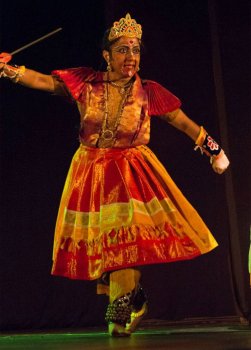
|
 |

|
 |
Priya Murle: Perspective in performance - Nanditha Ashok October 24, 2013  In both performance as well as conversation, Bharatanatyam dancer Priya Murle depicts dance as an art beyond the body and uses her talents to establish a connection with her audience; exactly what the Natya Shastra calls for in the act of creating pure rasa. As she gears up for the upcoming season, Priya Murle talks about her perspective on abhinaya and approach to choreography. What are some projects you are currently involved in? Currently, in addition to my solo choreography, I am working on a few projects for the season. First is Prof. Sudharani Raghupathy's new production called ‘Tripaada' where I am playing Mahabali in the retelling of Vamana Avataram story. Also, I am working with my group Parasaha which includes Roja Kannan, N. Srikanth and Aswathy Srikanth. We are doing a large-scale production on motherhood, in addition to other small programs. Your performance at Nritya Sangama recently caught the attention of a lot of people, because of its striking abhinaya and homage to very traditional nritta. Can you tell us about evolution of your choreography and abhinaya? I think the main thing I want to share here is that being under my guru Sudha Aunty (Sudharani Raghupathy) for the last four decades has really shaped my growth as an artiste. In many ways, I have choreographed movements with her original thought process in mind. I am really thankful to have gotten a glimpse of her mind over all these years. As for abhinaya, this is a field I have also researched extensively. Observing Aunty is one aspect. Another is also simply my wide range of interests in various characters. I always say that I am quite versatile and varied with the situations that catch my attention. Working with a wide range of artistes from Anita Ratnam, Chitra Visweswaran, Padma Subrahmanyam and Nandini Ramani has added to this. And of course, what I watch, what I read, and my relationships with people have helped my quest to connect with the audience through expression.  You mentioned research in abhinaya. Can you tell us more about that? Actually I have researched extensively and done my M. Phil in the field of aesthetics. Specifically, I worked on the concept of "sadharnikarana." What it really means is in the portrayal of a character, say Sita in a performance, you are neither yourself nor are you Sita. But you are essentially putting yourself in the perspective of that particular character while forgetting yourself. This has been the crux of my abhinaya approach. Lately, you have received accolades for taking on male roles. What are your thoughts on this newer area? Well, if I have to be honest, Sudha Aunty has always prepared us for various roles when we did dance dramas with her. So, I have played characters, male and female in the Ramayana, and her magnum opus ‘Krishnam Vande Jagatgurum.' Originally I was not going to play Shakuni in my group Parasaha's ‘Panchaali Sabadham.' But when my colleagues heard my imitation of Shakuni's laugh, they knew that I needed to play the role! I still really enjoy playing his character, because it is such a contrast to what I have played before. When K.S.R. Aniruddha, Sudha Aunty's son, asked me to play Indra in his production ‘Mammudha,' I was excited because I could learn and master the other art of Therukoothu which pushed my boundaries a lot. Finally, retelling the story of Amba/Shikandi was a magnificent experience which shook my preconceived notions on the Mahabharatha and gender concerns that people are raising today. What is your approach to teaching and training in abhinaya? Sudha Aunty is very particular about approaching abhinaya in a well researched manner but without losing spontaneity. I always make my students research a piece before they come to me with it. This means knowing the Padhaartha, Vaakyaartha and Kaavyartha meanings to it, word-for-word definitions as well as the overarching point. Then, we work together on formulating a given piece. Following the pattern of representing word-for-word meanings before extended sancharis, I urge students to think of manodharma as a figment of the character's thoughts. For example, why would Yashodha hit such a cute Krishna when he eats mud? I instead picture her begging and sweet talking him to listen. This was something that an audience member appreciated from my performance for Nritya Sangama. I also always share with students that pieces get better as you think about them, talk about them, and do them over and over again. Contact Priya Murle: pmurle@gmail.com  Post your comments Unless you wish to remain anonymous, please provide your name and email id when you use the Anonymous profile in the blog to post a comment. All appropriate comments posted with name & email id in the blog will also be featured in the site. |